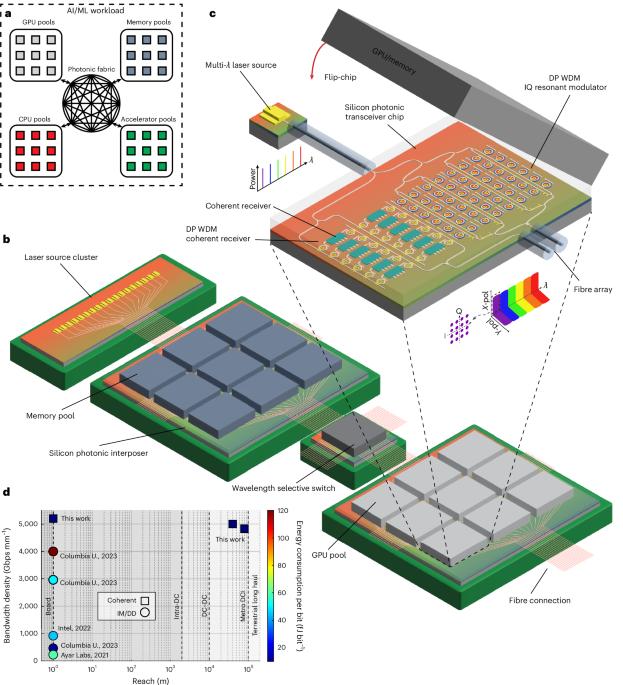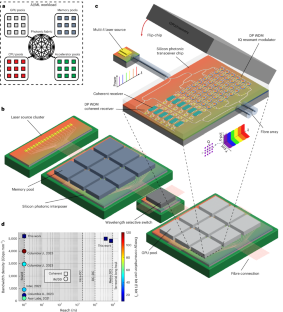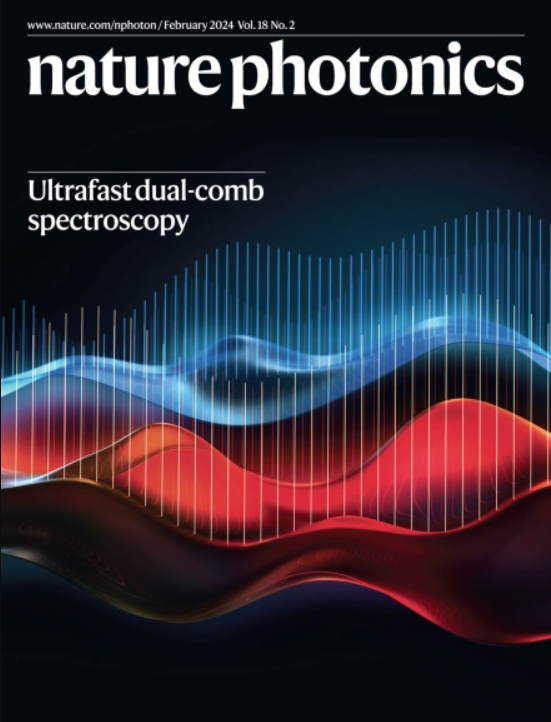微环调制器的超快相干动力学
IF 32.9
1区 物理与天体物理
Q1 OPTICS
引用次数: 0
摘要
下一代计算集群需要超高带宽光互连来支持大规模人工智能应用。这些电子-光子协整系统需要密集集成的高速电光转换器。在这种情况下,微环调制器(mrm)作为一种有前途的解决方案出现,因其卓越的紧凑性和能源效率而备受赞誉。然而,它们的潜力受到固有挑战的限制,例如明显的频率啁啾和动态非线性。此外,对它们的相干动力学还缺乏全面的认识,这进一步限制了它们的适用性和效率。因此,这些限制限制了它们的使用频谱效率低下的强度调制直接检测链路。在这里,我们对MRM相干动力学进行了深入的研究,解锁相位作为基于MRM的高级调制格式高速数据传输的新维度。我们证明了MRMs的相位和强度调制表现出明显的耦合动态,限制了它们在高阶调制格式中的直接应用。这一挑战可以通过在推拉配置的马赫-曾德干涉仪中嵌入一对MRMs来解决,从而实现双稳态相位响应和无啁啾调幅。此外,我们表明,与MRMs的相位和强度调制相比,其幅值频率响应表现出明显的频率失谐依赖性,在共振附近没有强峰值。利用超快相干动力学,我们设计并实验展示了一种超紧凑、超宽带的同相/正交调制器,该调制器采用互补金属-氧化物-半导体兼容光子工艺在硅芯片上制造。我们的设备实现了创纪录的片上岸线带宽密度,超过5 Tb s - 1 mm - 1,实现了符号速率高达180 Gbaud的相干传输,在80公里的跨度内实现了超过1 Tb s - 1的净比特率,调制能耗低至10.4 fJ bit - 1。本文章由计算机程序翻译,如有差异,请以英文原文为准。


Ultrafast coherent dynamics of microring modulators
Next-generation computing clusters require ultra-high-bandwidth optical interconnects to support large-scale artificial-intelligence applications. These electronic–photonic co-integrated systems necessitate densely integrated high-speed electro-optical converters. In this context, microring modulators (MRMs) emerge as a promising solution, prized for their exceptional compactness and energy efficiency. Nevertheless, their potential is curtailed by inherent challenges, such as pronounced frequency chirp and dynamic nonlinearity. Moreover, a comprehensive understanding of their coherent dynamics is still lacking, which further constrains their applicability and efficiency. Consequently, these constraints have confined their use to spectrally inefficient intensity-modulation direct-detection links. Here we present a thorough study of MRM coherent dynamics, unlocking phase as a new dimension for MRM-based high-speed data transmission in advanced modulation formats. We demonstrate that the phase and intensity modulations of MRMs exhibit distinct yet coupled dynamics, limiting their direct application in higher-order modulation formats. This challenge can be addressed by embedding a pair of MRMs within a Mach–Zehnder interferometer in a push–pull configuration, enabling a bistable phase response and unchirped amplitude modulation. Furthermore, we show that its amplitude frequency response exhibits a distinct dependency on frequency detuning compared with phase and intensity modulations of MRMs, without strong peaking near resonance. Harnessing the ultrafast coherent dynamics, we designed and experimentally demonstrated an ultra-compact, ultra-wide-bandwidth in-phase/quadrature modulator on a silicon chip fabricated using a complementary metal–oxide–semiconductor-compatible photonic process. Achieving a record on-chip shoreline bandwidth density exceeding 5 Tb s−1 mm−1, our device enabled coherent transmission for symbol rates up to 180 Gbaud and a net bit rate surpassing 1 Tb s−1 over an 80 km span, with modulation energy consumption as low as 10.4 fJ bit−1. An ultra-compact, ultra-wide-bandwidth in-phase/quadrature modulator on a silicon chip is demonstrated, enabling coherent transmission for symbol rates up to 180 Gbaud and a net bit rate surpassing 1 Tb s−1 over an 80 km span, with modulation energy consumption as low as 10.4 fJ bit−1, and promising enhanced performance and scalability for future networking infrastructures.
求助全文
通过发布文献求助,成功后即可免费获取论文全文。
去求助
来源期刊

Nature Photonics
物理-光学
CiteScore
54.20
自引率
1.70%
发文量
158
审稿时长
12 months
期刊介绍:
Nature Photonics is a monthly journal dedicated to the scientific study and application of light, known as Photonics. It publishes top-quality, peer-reviewed research across all areas of light generation, manipulation, and detection.
The journal encompasses research into the fundamental properties of light and its interactions with matter, as well as the latest developments in optoelectronic devices and emerging photonics applications. Topics covered include lasers, LEDs, imaging, detectors, optoelectronic devices, quantum optics, biophotonics, optical data storage, spectroscopy, fiber optics, solar energy, displays, terahertz technology, nonlinear optics, plasmonics, nanophotonics, and X-rays.
In addition to research papers and review articles summarizing scientific findings in optoelectronics, Nature Photonics also features News and Views pieces and research highlights. It uniquely includes articles on the business aspects of the industry, such as technology commercialization and market analysis, offering a comprehensive perspective on the field.
 求助内容:
求助内容: 应助结果提醒方式:
应助结果提醒方式:


